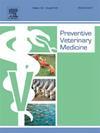A tale of two labs: Comparing antimicrobial resistance data in pets across commercial and academic diagnostic laboratories
IF 2.4
2区 农林科学
Q1 VETERINARY SCIENCES
引用次数: 0
Abstract
Antimicrobial resistance *AMR) presents significant challenges in veterinary medicine, necessitating accurate surveillance to inform effective mitigation strategies. Most resistance estimates for cats and dogs are based on a single data source, typically university-affiliated diagnostic laboratories *UADLs), which may limit their generalizability. This study is the first to quantitatively compare AMR data from a UADL and a commercial diagnostic laboratory *CDL) by analyzing antimicrobial susceptibility testing *AST) results for Escherichia coli and Staphylococcus pseudintermedius in cats and dogs from New York State between 2019 and 2022. The analysis focused on first-line and higher-tier antimicrobials and revealed a tendency for the UADL data to observe lower susceptibility rates than the CDL. However, the extent of this difference varied by bacteria-antimicrobial combination, geographic region, and time. A secondary objective was to develop and test a novel Shiny application designed to harmonize and prepare data for comparison without exchanging raw data, addressing several data-sharing concerns that could limit collaboration. These findings highlight how variations in data sources can affect resistance estimates and interpretations. By identifying similarities and differences, this study underscores the importance of considering data source characteristics when analyzing and applying AMR surveillance reports. Integrating data from multiple sources may provide a more balanced and representative understanding of resistance patterns, thereby supporting more effective surveillance and decision-making in companion animal medicine. Here, we demonstrate that user-friendly analysis tools can support data integration without requiring raw data to be publicly available or shared between institutions.
两个实验室的故事:比较商业和学术诊断实验室的宠物抗菌素耐药性数据
抗菌素耐药性(AMR)是兽医学面临的重大挑战,需要进行准确的监测,以便为有效的缓解战略提供信息。大多数猫和狗的耐药性估计都是基于单一数据源,通常是大学附属诊断实验室(UADLs),这可能限制了它们的普遍性。这项研究首次通过分析2019年至2022年纽约州猫和狗的大肠杆菌和假中葡萄球菌的抗菌药物敏感性测试结果,定量比较了UADL和商业诊断实验室(CDL)的AMR数据。该分析侧重于一线和更高级的抗菌素,并揭示了UADL数据的敏感性低于CDL的趋势。然而,这种差异的程度因细菌-抗菌素组合、地理区域和时间而异。第二个目标是开发和测试一个新的Shiny应用程序,该应用程序旨在在不交换原始数据的情况下协调和准备用于比较的数据,解决可能限制协作的几个数据共享问题。这些发现强调了数据来源的差异如何影响耐药性的估计和解释。通过识别异同,本研究强调了在分析和应用抗生素耐药性监测报告时考虑数据源特征的重要性。整合来自多个来源的数据可以提供对耐药性模式更平衡和更具代表性的理解,从而支持在伴侣动物医学中更有效的监测和决策。在这里,我们展示了用户友好的分析工具可以支持数据集成,而不需要原始数据公开可用或在机构之间共享。
本文章由计算机程序翻译,如有差异,请以英文原文为准。
求助全文
约1分钟内获得全文
求助全文
来源期刊

Preventive veterinary medicine
农林科学-兽医学
CiteScore
5.60
自引率
7.70%
发文量
184
审稿时长
3 months
期刊介绍:
Preventive Veterinary Medicine is one of the leading international resources for scientific reports on animal health programs and preventive veterinary medicine. The journal follows the guidelines for standardizing and strengthening the reporting of biomedical research which are available from the CONSORT, MOOSE, PRISMA, REFLECT, STARD, and STROBE statements. The journal focuses on:
Epidemiology of health events relevant to domestic and wild animals;
Economic impacts of epidemic and endemic animal and zoonotic diseases;
Latest methods and approaches in veterinary epidemiology;
Disease and infection control or eradication measures;
The "One Health" concept and the relationships between veterinary medicine, human health, animal-production systems, and the environment;
Development of new techniques in surveillance systems and diagnosis;
Evaluation and control of diseases in animal populations.
 求助内容:
求助内容: 应助结果提醒方式:
应助结果提醒方式:


